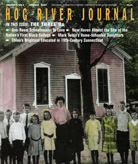(c) Connecticut Explored Inc. Summer 2007
Subscribe/Buy the Issue!
Without fail, each issue of HOG RIVER JOURNAL provides me with an “aha!” moment. When I handed the spring (2007) “Bite the Bullet” issue to my mother, she informed me that our family tree included a Sweet, a member of the bonesetting family featured in Maureen Welch and Alicia Wayland’s “A Knack for Bonesetting.” (I’m sure I should have known that!) Back in 2004, a photo essay of Connecticut’s “Rosie the Riveters” in our “On the Homefront” issue surfaced a photo of my husband’s grandmother sewing parachutes for the Pioneer Parachute Company in Manchester in 1942. My husband’s relatives hadn’t known this image from the Library of Congress archives existed and were delighted at its discovery.
Most of my “aha'” moments aren’t so personal, though. In developing this issue about the state’s educational history, I was most surprised when I learned that Connecticut once owned part of Ohio (see “West of Eden,” page 20). By decree of King Charles II, Connecticut roughly considered its northern and southern borders to follow the latitudinal parallels as far west as there was land (the existence of New York and Pennsylvania, apparently, notwithstanding.) But the story got even better. The sale of that land in 1795 created a state fund to pay for public school education—and that fund continues to serve that purpose today. We are happy that Lary Bloom, former editor of The Hartford Courant’s Northeast magazine and current columnist for Connecticut magazine and the Connecticut section of The New York Times, agreed to write the story-in part because he grew up in “New Connecticut” (as that part of Ohio was once called). To dig into the murky details of what became of that 212-vear-old school fund, we turned to historian and researcher Tom Howard, and we thank him for his help in unraveling that story.
I’m not the only one experiencing surprise and revelation through HOG RIVER JOURNAL. Susan Chandler stumbled on a few “aha!” moments herself when writing about the founding in New Haven of America’s first professional cooking school (see page 46). Student Michelle Wong was delighted to learn of a fellow Chinese student’s attendance at The Gunnery 122 years before her time there (see page 48). Beth Rose’s Soapbox gives readers a jolt by illuminating the dire need for better history education for our youth. And members of the editorial team were surprised, when we set out to compile a simple story about one-room schoolhouses (see page 12), to learn that there were once more than 1,100 of the structures dotting Connecticut’s 169 towns.
And then there are the “aha!” moments in which the inflection is not of delighted surprise but of sad
realization that Connecticut has not always been as progressive as we’d like to think. Amherst College professor Hilary Moss’s account of the unsuccessful attempt to found the nation’s first (first!) black college, in New Haven, in 1831 is a prime example (see page 32). I suppose it should be no surprise that progress has come in fits and starts, sometimes in spite of great resistance, at great cost, and with great delay. With 20/20 hindsight we now look back on this episode and wonder why the prospect of improvement via education for the Black minority population evoked so much fear among the white majority population. Can history teach us something about how a fear of the unknown, fear for our security and our livelihoods, might motivate opposition to change in today’s uncertain world?
The promise of the next “aha!” moment—whether it be pleasant or cringe inducing—keeps the editorial team energized for the next issue. We are all—and our readers, too, I suspect—dedicated life-long learners. And that’s what this issue in particular, but every issue, really, is all about.
Explore!
Read all of our stories in the Summer 2007 issue
Read all of our stories about Childhood in Connecticut history on our TOPICS page

